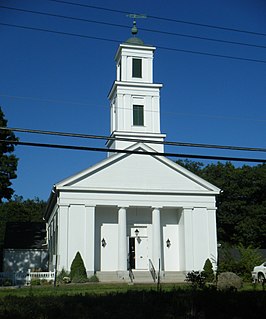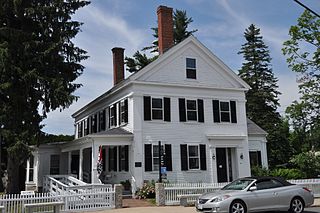
Barton Hall, also known as the Cunningham Plantation, is an antebellum plantation house near present-day Cherokee, Alabama. Built in 1840, it is a stylistically rare example of Greek Revival architecture in Alabama, with elements from the late Federal period. The house was designated a National Historic Landmark in 1973 for its architecture.

The Israel Putnam School is a historic school in Putnam, Connecticut. The school, named in honor of Israel Putnam, is a two-story Classical Revival brick building with limestone trim built in 1902. It was the town's first modern school building, and the first to include an auditorium. The building was listed on the National Register of Historic Places in 1984. It has been converted to residences.

The Nathaniel Thayer Estate is a historic house in Lancaster, Massachusetts. Built in 1846 and extensively restyled in 1902, it is a particularly fine example of Georgian Revival architecture, and was added to the National Register of Historic Places in 1976. Since 1946, the estate has been owned by the Seventh-day Adventist Church, which operated Atlantic Union College there until its 2018 closure. The main house is presently home to Thayer Conservatory, bringing community together through music and the arts.

The Clark–Northrup House is a historic house in Sherborn, Massachusetts. Built c. 1845–55, it is a locally unusual example of a Greek Revival house with a more traditional Georgian side-gable roof. The house was listed on the National Register of Historic Places in 1986.

The United States Post Office–Wakefield Main is a historic post office building at 321 Main Street in Wakefield, Massachusetts. Built in 1936 as part of a Depression-era works project, it is a Classical Revival structure that harmonizes with its neighbors. The building was listed on the National Register of Historic Places in 1987, and included in the Common District in 1990.

The former U.S. Post Office in Canandaigua, New York, is located on North Main Street. It is a Classical Revival granite structure built in 1910 and expanded in 1938. It was listed on the National Register of Historic Places both as a contributing property to the Canandaigua Historic District in 1984 and individually in 1988, as part of a Multiple Property Submission of over 200 post offices all over the state.

The Nathaniel Backus House is a two-story Greek Revival clapboarded house with a gable roof in Norwich, Connecticut. The house was built around 1750 by Nathaniel Backus and served as his home, it was later moved to its current location in 1952. The house originally began as a Colonial, but was greatly modified to Greek Revival around 1825, reconfiguring the central door to the left of the facade and adding two chimneys. The house is a historic house museum operated by the Faith Trumbull Chapter of the Daughters of the American Revolution.

The Marlborough Congregational Church is a historic Congregational Church at 35 South Main Street in Marlborough, Connecticut. Built in 1842, it is a well-preserved example Greek Revival architecture. In addition hosting religious services, it also hosted town meetings for many years. It was listed on the National Register of Historic Places in 1993.

The Uncasville School is a historic school building at 310 Norwich-New London Turnpike in the Uncasville section of Montville, Connecticut. Designed by architect Wilson Potter, it was built during 1917-1918 by local contractor H. R. Douglas. In 1925 it was expanded by a major addition. A fine local example of Renaissance Revival architecture, its construction was funded by Grace Palmer Melcer, the daughter of a local industrialist. The building was added to the National Register of Historic Places in 2001. The building now houses town offices.

The Greenwich Avenue Historic District is a historic district representing the commercial and civic historical development of the downtown area of the town of Greenwich, Connecticut. The district was listed on the National Register of Historic Places on August 31, 1989. Included in the district is the Greenwich Municipal Center Historic District, which was listed on the National Register the year before for the classical revival style municipal buildings in the core of Downtown. Most of the commercial buildings in the district fall into three broad styles, reflecting the period in which they were built: Italianate, Georgian Revival, and Commercial style. The district is linear and runs north–south along the entire length of Greenwich Avenue, the main thoroughfare of Downtown Greenwich, between U.S. Route 1 and the New Haven Line railroad tracks.

The Greenwich Senior Center, formerly Greenwich Town Hall, is a historic municipal building at 299 Greenwich Avenue in the business district of Greenwich, Connecticut. USA. Built in 1905, it is a prominent local example of Beaux Arts architecture, and served as the town's center of government until 1977. The building was added to the National Register of Historic Places on May 21, 1987.

The Byram School is a historic former school building, located between Sherman Avenue and Western Junior Highway in Greenwich, Connecticut. Completed in 1926, it is a well-preserved example of institutional Colonial Revival architecture, enhanced by a parklike setting. It was used as a school until 1978, and was then converted to senior housing. The building was listed on the National Register of Historic Places on August 2, 1990.

The Josiah Wilcox House is a historic house at 354 Riversville Road in Greenwich, Connecticut. Built in 1838, it is one of the town's finest examples of Greek Revival architecture. It was listed on the National Register of Historic Places in 1988.

The Nathaniel Witherell is a rehabilitation and skilled nursing facility at 70 Parsonage Road in Greenwich, Connecticut. It is owned and operated by the town on a non-profit basis, providing a range of primarily short-term care services on a 24-acre (9.7 ha) campus north of the central business district. It was established in 1903, and its campus has been listed on the National Register of Historic Places.

The Weiss Center, formerly the U.S. Post Office-Manchester Main is a historic building at 491 Main Street in Manchester, Connecticut. It was built in 1931 and was listed on the National Register of Historic Places in 1986 for its architecture. It includes Colonial Revival, Classical Revival, and Georgian Revival architectural features.

The Bass Harbor Memorial Library is the public library of Tremont, Maine. It is located at 89 Bernard Road in the village of Bernard, in an historically significant Colonial Revival building built in 1922 with funds donated by Tremont native Rhoda M. Watson. The building was listed on the National Register of Historic Places in 2009.

The Jewett-Eastman House is a historic house at 37 Portland Street in the center of South Berwick, Maine. Built about 1850, it is a fine local example of Greek Revival architecture. It is most notable for its association with the Jewett family, which included a prominent local businessman and a doctor, as well as the writer Sarah Orne Jewett, who was raised in this house. It served the town for a time as its public library, and is now owned by Historic New England, serving as a gallery space and as the visitors center for the adjacent Sarah Orne Jewett House.

The Winsted Green Historic District encompassing the historic town green of Winsted, Connecticut, and a collection of historic buildings that face it. It extends northward from the junction of United States Route 44 and Connecticut Route 8 to Holabird Avenue, and features a diversity of architecture from the early 19th to 20th centuries, reflecting the city's growth. The district was listed on the National Register of Historic Places in 1977, and slightly enlarged in 1982.

The Kennebec County Courthouse is located at 95 State Street in Augusta, Maine, the state capital and county seat of Kennebec County. Built in 1829 and twice enlarged, it is one of the oldest examples of Greek Revival architecture in the state, and its earliest known example of a Greek temple front. The building, which is now mostly taken up by county offices, was listed on the National Register of Historic Places in 1974.





















